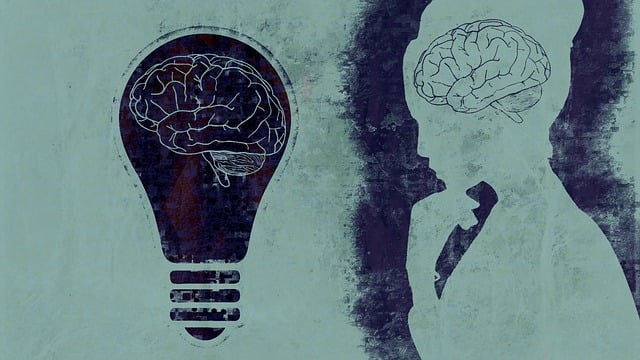Mental health professionals play a crucial role in identifying and mitigating risk factors for their clients, including past trauma, current stressors, substance abuse, and suicidal ideation. Greenwood Village Suicide Prevention Therapy offers a pioneering approach to suicide prevention by focusing on early intervention, long-term support, advanced therapeutic techniques, education, and public awareness campaigns. This holistic strategy destigmatizes mental health issues, encourages help-seeking behaviors, and promotes resilience building. Through comprehensive risk assessments and targeted interventions, therapists at Greenwood Village develop strong client-therapist relationships based on empathy and active listening, empowering individuals to manage distress effectively. Continuous training and professional development are essential for mental health professionals to stay current with evidence-based methods and best practices, ensuring improved client outcomes and system resilience.
Mental health professionals are constantly navigating complex risks within their practice. This article delves into a comprehensive risk assessment framework, focusing on crucial aspects like understanding risk factors, unique therapeutic approaches (e.g., Greenwood Village Suicide Prevention Therapy), and creating safe environments. We explore client vulnerability and strength assessments, continuous training for risk management, and best practices to foster resilience in both professionals and clients. By integrating strategies such as Greenwood Village’s innovative methods, mental health practitioners can enhance their ability to mitigate risks effectively.
- Understanding Risk Factors in Mental Health Practice
- Greenwood Village Suicide Prevention Therapy: A Unique Approach
- Assessing Client Vulnerabilities and Strengths
- Creating a Safe and Supportive Therapy Environment
- Continuous Training and Professional Development for Risk Management
Understanding Risk Factors in Mental Health Practice

Mental health professionals are often on the front lines when it comes to identifying and mitigating risk factors for their clients. Understanding these risks is paramount in providing effective care, especially considering the sensitive nature of mental health issues. Risk assessment involves a comprehensive evaluation of various elements, including but not limited to past traumatic experiences, current life stressors, substance abuse, and suicidal ideation. Identifying these factors is crucial, as it allows professionals to tailor interventions that can prevent escalating issues such as depression or even Greenwood Village suicide prevention therapy cases.
By recognizing potential risks, therapists and counselors can offer tailored Trauma Support Services and focus on Resilience Building within their practice. This proactive approach ensures that clients receive the necessary tools and support to manage and overcome challenges, ultimately enhancing their well-being. Moreover, staying vigilant about risk factors enables mental health professionals to quickly intervene and potentially save lives, making their role in Depression Prevention even more impactful.
Greenwood Village Suicide Prevention Therapy: A Unique Approach

In recent years, Greenwood Village has emerged as a leader in innovative mental health care with its unique approach to suicide prevention therapy. This community-driven initiative focuses on early intervention and long-term support for individuals at risk of self-harm. By combining advanced therapeutic techniques, education, and public awareness campaigns, the program aims to destigmatize mental health struggles and encourage help-seeking behaviors. The success of this strategy lies in its holistic nature, addressing not only immediate crisis management but also promoting mood management skills and depression prevention strategies.
Greenwood Village Suicide Prevention Therapy leverages community resources and involves local businesses, schools, and healthcare providers in the development of comprehensive support networks. This collaborative approach ensures that those at risk have access to a web of support, fostering an environment where mental well-being is prioritized. Through public awareness campaigns and educational workshops, the initiative raises understanding about mood disorders, encouraging early detection and intervention. By integrating these prevention strategies into the fabric of the community, Greenwood Village is making significant strides in improving mental health outcomes and saving lives.
Assessing Client Vulnerabilities and Strengths

When conducting a risk assessment for mental health professionals, assessing client vulnerabilities and strengths is a crucial step. This involves understanding not just the potential risks and triggers within a client’s life but also their coping mechanisms and protective factors. By employing empathy building strategies, therapists can gain valuable insights into their client’s resilience, which plays a significant role in risk management planning for mental health professionals like those offered at Greenwood Village Suicide Prevention Therapy.
Identifying vulnerabilities allows professionals to tailor interventions while leveraging strengths helps in fostering resilience. This dual approach not only enhances the effectiveness of therapy but also underscores the importance of comprehensive risk assessment in the hands of skilled practitioners. Through these methods, therapists can better navigate complex cases and contribute to the long-term well-being of their clients.
Creating a Safe and Supportive Therapy Environment

Creating a safe and supportive therapy environment is paramount for mental health professionals to ensure client well-being and effective treatment. This involves cultivating a space where individuals feel comfortable expressing their thoughts and emotions without fear of judgment or repercussions. At Greenwood Village Suicide Prevention Therapy, we prioritize building trust through active listening, empathy, and non-judgmental attitudes, fostering an atmosphere that encourages vulnerability and openness.
Effective communication strategies, including clear and concise language, are integral to this process. Additionally, incorporating coping skills development and trauma support services within the therapy environment equips clients with valuable tools to manage distress and navigate challenging experiences. By promoting a culture of safety and support, mental health professionals can facilitate meaningful healing and personal growth.
Continuous Training and Professional Development for Risk Management

Mental health professionals must embrace continuous training and professional development to effectively manage risks within their practice. Staying up-to-date with the latest research and techniques is essential, especially in a field as dynamic as mental health care. This ongoing learning ensures that therapists can navigate complex situations, such as those involving suicidal ideation or severe trauma, using evidence-based methods. For instance, Greenwood Village Suicide Prevention Therapy highlights the significance of training in compassion cultivation practices and emotional intelligence to foster deeper connections with clients at risk.
Regular workshops, seminars, and peer-led discussions allow professionals to enhance their skills, including confidence-boosting techniques crucial for handling high-risk cases. By prioritizing professional development, therapists can better equip themselves to recognize early warning signs, implement effective interventions, and adapt treatment plans based on individual needs. This commitment to ongoing learning not only improves client outcomes but also contributes to the overall resilience of the mental health care system.
Mental health professionals must navigate a complex landscape of risk factors, from client vulnerabilities to their own well-being. Implementing strategies like Greenwood Village Suicide Prevention Therapy, which focuses on creating safe spaces and continuous training, can significantly enhance risk management. By assessing both client strengths and weaknesses, therapists can foster supportive environments that mitigate potential risks. This holistic approach, combined with regular professional development, ensures practitioners are equipped to provide the best care possible while safeguarding their own mental health.










